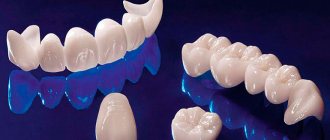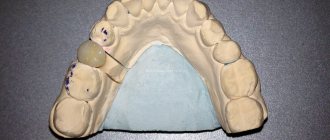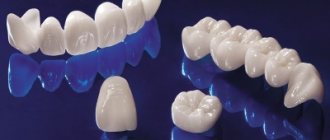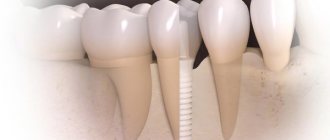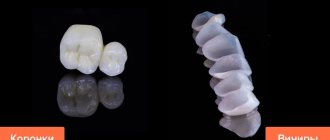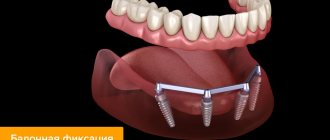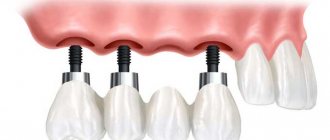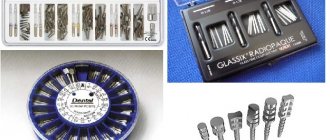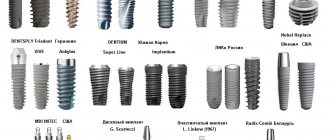Metal-free zirconium dioxide crowns
Metal-free crowns made of zirconium dioxide.
Metal-free crowns are
the latest achievement in dental practice and are the most
aesthetic and reliable method of prosthetics.
The name suggests that the concept of moving away from the metal frame has taken place. The era of metal-free structures has firmly entered dental practice and is likely to remain there for a long time. Patients are offered two types of metal-free crowns,
from E.max (I-Max) and
from zirconium dioxide
(ZrO2), manufactured
in Germany
.
Depending on the clinical situation, these materials can be used not only separately, but also together. They complement each other and make it possible to give artificial teeth the effect of naturalness and transparency, which is practically absent in metal-ceramic structures. Externally, they practically do not differ from natural teeth and have a “living shine”. But still there are a number of differences between them: in manufacturing technology and in physical properties. Today, there are two methods for producing metal-free crowns,
these are the pressing method (E-max) and the “cad/cam” technology, using the milling method (zirconium dioxide)
Installation steps.
Installation of metal-free zirconium crowns does not require deep tooth preparation (gentle
technique), so they can be placed on living teeth, on pulpless teeth (“dead”), on implants, on front teeth, with bruxism and pathological abrasion. Successful prosthetics with metal-free zirconium dioxide crowns consists of many important details and nuances. The installation and production of crowns takes place quickly in two stages: preparation, taking impressions and fixing the finished structure. However, with complex prosthetics, in the manufacture of structures for implants, additional installation steps are required.
- Installation of zirconium crowns and bridges on implants
requires an additional step to comply with
the prosthetic protocol.
The production of an individual tray and the transfer of receipts guarantees patients a highly aesthetic and long-term result in prosthetics after implantation.
Installation on the chewing group of teeth
requires strength to withstand chewing loads, so all-milled zirconium dioxide crowns with full anatomy are ideal for this task.- Installation on the front teeth with a large dentition defect
(more than three units) requires the manufacture of combined crowns based on zirconium dioxide, since aesthetics is a priority for the patient. - Installation of crowns made of zirconium dioxide for bruxism and pathological abrasion
, with a problem with the joint, requires high functional properties from the structure and combined crowns based on zirconium dioxide are the best choice for the patient.
IMPORTANT:
Therefore, doctors at the Dentist dental clinic use crowns and zirconium dioxide and
E-max
in various combinations. This allows not only to restore the functionality of the tooth, but also not to disrupt the functioning of the temporomandibular joint.
What is zirconium dioxide ZrO2.
Zirconium oxide or dioxide ZrO2 is a metal that exists in nature as a mineral
baddeleyite. It is a super-hard mineral that can exist in three crystalline forms. When exposed to high temperatures, crystals of cubic zirconia or zircon are formed. Zircon has a high refractive index and therefore is used in jewelry as an imitation of diamonds and is called cubic zirconia. Of course, zircon oxide can be called a new unique material for the manufacture of dental crowns
and
inlays
. And the high biocompatibility of ZrO2 allowed the Straumann company to create a unique cone-shaped implant that completely imitates the native tooth root!
Zirconium dioxide crowns: pros and cons.
Metal-free crowns made of zirconium dioxide, the most modern, aesthetic and functional. A
Since there is no metal in their composition, they are lightweight. The absence of metal allows them to be used in those patients who have an allergic reaction to metal. Crowns made of zirconium dioxide have proven themselves well in prosthetics on implants.
Pros:
- High biocompatibility with dental tissues.
- Super-hard material that can withstand heavy loads ZrO2 = 1200 ppm! High strength!
- Aesthetics and light transmission.
- Can be combined with various types of ceramics, including E.max.
- Possibility of choosing a fixation option, screw or cement
. - The color scale of ZrO2 has expanded, which makes it possible to produce works in full anatomy (mainly the chewing group of teeth)
- Maintains healthy gum tissue.
- They fit well and do not injure the gingival margin.
- Functional and reliable.
- They solve aesthetic problems of teeth in connection with color, shape and position.
Perhaps the only drawback or disadvantage
of this material is its price. The production of structures from zirconium dioxide requires the use of modern equipment (CAD/CAM complex) and high-precision technologies!
Reviews.
Svetlov Eldar
September 16, 2020 15:40
Greetings to everyone!
At the Dentist dentistry at the beginning of this summer, Valentina Vladimirovna installed 7 crowns on implants for me! I am completely satisfied with the result of the prosthetics. Still, whatever one may say, ceramics are the best option for crowns! I would like to note the doctor’s excellent work, she was the one who did both prosthetics and treatment before this! +7-985-24XXXXX
I wanted to get crowns and was looking for a good specialist. After asking around among friends and acquaintances, I found Valentina from the Dentist clinic. I was pleased with the way she handled the appointment, so I will contact her again in the future if necessary. Don't find fault with the crowns! The installation is painless and looks like real teeth. I liked the clinic too. Spacious, rich, beautiful design. I just want to touch and examine everything! The staff is well trained. I advise you to take note.
Indications and contraindications for installation.
According to reviews from dentists
, zirconium crowns do not injure the gingival margin,
they are functional and reliable, so they are recommended when it is necessary to install:
- Single crowns with full anatomy for implants.
- Single crowns and bridges on your own teeth.
- Long-term bridges on implants in the area of chewing teeth.
Metal-free zirconium dioxide crowns
can be installed on a living tooth, on a “dead” tooth, or on an implant.
Bruxism and pathological abrasion
are
not contraindications for the installation of zirconium crowns.
Metal-free crowns made of zirconium dioxide using cad/cam technology.
Working with zirconium dioxide requires a new approach and new technologies. Zirconium dioxide definitely
involves an expensive set of CAD/CAM equipment.
Digital technologies in dentistry are developing at a fairly rapid pace and a striking example of this is CAD/CAM technology. In other words, this is a modern technology for manufacturing denture frames and crowns using computer modeling and milling. For the production of metal-free zirconium dioxide crowns using cad/cam technology
zirconium dioxide (ZrO2) and translucent zirconium dioxide are used (this is the same zirconium dioxide, but with increased light transmittance). The patient's impression is sent to the laboratory and a model is cast, which is scanned and appears
digital virtual 3D image of the model on a computer.
The dental technician begins modeling the future individual design for the patient on the monitor screen, in the form of a three-dimensional animated model. Once the modeling is complete, the milling machine produces a metal-free crown or bridge based on the 3D model created earlier. IMPORTANT:
The advantages of CAD/CAM systems are that they allow you to obtain high-precision metal-free structures for natural teeth and implants in a very short time.
Metal-free crowns
and bridges
made from zirconium dioxide using cad cam
have excellent marginal fit, which prevents secondary caries. During the manufacturing process of metal-free crowns, the “human factor” is reduced to a minimum.
Types of metal-free zirconium crowns.
Theoretically, any tooth can be restored with a zirconium dioxide crown. But the doctor must
take into account the functional characteristics of the masticatory apparatus, and choose the technique that will predict a stable positive result. The choice of technology depends on the specific situation in the patient’s oral cavity. Today, two types of metal-free crowns are made from zirconium dioxide:
Fully milled crowns, machined entirely from zirconium dioxide
and the shape is set initially (full anatomy). Such crowns are recommended to be installed in situations where strength is important. This prosthetics is more recommended for the chewing group of teeth. They have proven themselves excellent in prosthetics on implants.
Combined crown - frame made of zirconium dioxide,
lined with ceramic mass .
It is recommended to make such crowns for the front teeth, where aesthetic perception is important.
We use what is best for the patient in his particular case. When choosing a design, of course, you need to take into account many subtleties, if aesthetics is a priority for the patient, and metal-free E.max crowns
. on large dentition defects (more than three units), then these two materials are used together. A zirconium dioxide “base” (framework) is made and E-max is applied using the layering method. And we get a functional, reliable and aesthetic design.
Cost of zirconium dioxide crowns.
Price
in Moscow, the cost of
metal-free zirconium dioxide crowns
depends on many factors:
the status of the clinic, the selected material, the number of teeth that need to be restored. The final result largely depends on the professionalism of doctors and dental technicians. In this regard, it is natural that prices are fully influenced by the status and reputation of the clinic.
Price
for prosthetics with zirconium dioxide crowns with complete or partial absence of teeth cannot be low. Considering that the service life of metal-free crowns is on average 15 years, this is a profitable investment.
Zirconium dioxide crowns
judging
by the reviews
of patients and dentists, they are recognized as the most
durable, aesthetic, functional, reliable and safe.
At the Danist clinic, the installation of zirconium dioxide crowns is carried out by specialists with extensive experience
works that thoroughly master the methodology. This approach, combined with the use of the highest quality materials and computer technology, guarantees the success of orthopedic treatment and positive feedback from patients.
“Danist” near the Chistye Prudy metro station is one of the best clinics in Moscow, so if the goal is to preserve an excessively damaged tooth and obtain a high aesthetic result from prosthetics, then you should come here.
Our patients are always satisfied with the results of our work!
What is zirconium oxide?
There are currently quite a lot of materials for making crowns.
One of them is zirconium oxide. This is a very popular modern ceramic material, which is the result of the introduction of high technology in the field of dentistry. It is the high strength, biocompatibility and aesthetics of zirconium oxide that have made it one of the most popular materials for dental prosthetics. The discovery of zirconium oxide is associated with the mineral zircon (Fig. 1), about which there are many ancient legends. More than three thousand years ago, on the island of Ceylon, zircon was used as an imperfect diamond and was used to make jewelry. The shiny stones were called “Matara diamonds”, since their source was one of the regions of Ceylon - Matara. There are several versions about who gave the modern name to the “imperfect diamond.” According to some sources, the German scientist Brückner in 1778 named it with the Arabic word “zarkun”, which means “mineral”. According to others, the discoverer of zircon is considered to be the chemist Werner (1783), who gave the mineral the name “tsargun” from two Persian words “tsar” - “gold” and “gun” - “color”. Still other sources claim that “zircon” is a modification of the common folk “jargon” - “deceiver”, i.e. "fake diamond" The mineral zircon began to be officially mentioned in scientific works in the 80s of the 18th century. In 1789, the German chemist Martin Heinrich Klaproth published the results of an analysis of a gemstone brought from the shores of Ceylon. During this analysis, a substance was isolated that Klaproth called “zirconium earth”; this was zirconium oxide.
Fig.1. Mineral zircon
There is currently some terminological confusion that needs to be cleared up. The zircon mineral Zirkon (ZrSiO4) is a zirconium silicate. Contains impurities of various metals. Based on color and transparency, the following types of zircon are distinguished: hyacinth - transparent, red, red-orange, red-brown, purple (Fig. 2); jargon - transparent, honey-yellow, smoky, colorless and starlite - transparent, blue. Zirconium oxide also occurs naturally as the mineral baddeleyite (Fig. 3).
Fig.3. Mineral baddeleyite
Zirconium Zirconium (Zr) is a chemical element of group IV of D. I. Mendeleev’s periodic table. Pure zirconium exists in two forms: the crystalline form is a soft, malleable metal of a grayish-white color (Fig. 4); amorphous form - bluish-black powder. It is not found in nature in its pure form; pure zirconium, free from impurities, was obtained only at the beginning of the 20th century.
Fig.4. Metal zirconium Zr
The minerals zircon and baddeleyite cannot be used in medicine due to the large number of impurities of various metals, which give them an unsuitable color for use, and impurities of radioactive metals (uranium, thorium). High-purity zirconium oxide is produced chemically. Zirconium oxide (dioxide) (ZrO2), in English-speaking countries the term Zirconia is acceptable, is one of the most refractory metal oxides, the melting point is 2715 °C. It exhibits amphoteric properties, is insoluble in water and aqueous solutions of most acids and alkalis, but dissolves in hydrofluoric and concentrated sulfuric acids, molten alkalis and glasses. Zirconium oxide exists in the form of three crystalline phases: monoclinic (M), tetragonal (T) and cubic (C). During heating, zirconium oxide undergoes a phase transformation process, that is, a transition from one phase to another, and a change in volume occurs. To suppress phase transformations of zirconium oxide and obtain materials with the desired properties, stabilizing metal oxides are added to it, for example, oxides of calcium, magnesium, yttrium, and cerium. Depending on the amount of stabilizing agent, fully or partially stabilized zirconium oxide is distinguished. The stable monoclinic phase (M) is found in nature in the form of the mineral baddeleyite, the metastable medium-temperature tetragonal (T) phase is part of zirconium ceramics, the unstable high-temperature cubic (C) phase stabilized by impurities of various metal oxides, due to its high refractive index and dispersion, is used in jewelry as an imitation of diamonds; in the USSR, such crystals were called cubic zirconia (Fig. 5), from the Physical Institute of the Academy of Sciences (FIAN), where they were first synthesized. But the name cubic zirconia is practically not used outside the former USSR and Eastern European countries. Abroad, this material is more often called jewalite and zirconite. In some cases, especially in translations from foreign languages, cubic zirconia is called zirconium or zircon (Fig. 6), which creates confusion, since cubic zirconia is a synthetic material imitating diamond, zircon is an unrelated mineral, and zirconium is a chemical element.
Fig.5. cubic zirconia
Fig.6. Types of cubic zirconia (cubic phase zirconium oxide)
The refractive index of cubic zirconia (2.15-2.25) is close to diamond (2.417-2.419), so it is difficult to distinguish them by eye. Due to this, they are often used in jewelry (Fig. 7). Gold jewelry can be decorated with cubic zirconia inserts. In costume jewelry, they are used to contrast the transparency or color of the main insert (the center of the composition), or as an imitation of diamonds. They are also used in dentistry for ceramic spraying and in the chemical industry. In addition, in dentistry they are used to decorate teeth - to make skyes (Fig. 8).
Fig.7. Jewelry with cubic zirconia
Fig.8. Skyes
In industry, zirconium oxide is widely used due to its unique properties (high hardness, low thermal conductivity, etc.). In the automotive industry, it is used to make brake discs for high-end sports cars. In the space industry, shuttle heat shields help ships withstand incredible temperatures. It is used in the production of refractories, technical ceramics, heating elements; enamels, glass, and cutting tools are made from it. Everyone is well aware of ceramic knives (Fig. 9), which have become firmly established in our everyday life. When heated, zirconia conducts current, which is sometimes used to produce heating elements that are stable in air at very high temperatures. Heated zirconium oxide is capable of conducting oxygen ions as a solid electrolyte. This property is used in industrial oxygen analyzers. It is also used in medicine, for example, as spherical heads of artificial hip joints (Fig. 10, 11). And finally, in dentistry, he can show all his best qualities in the role of dentures.
Fig.9. Zirconium Oxide Ceramic Knives
Fig. 10. Hip endoprostheses made of various materials
Fig. 11. Hip joint friction couple ceramic-zirconium oxide ceramic
